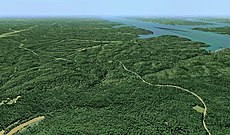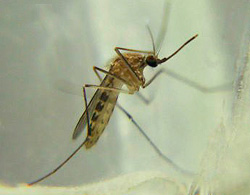User:Kir/Sandbox3: Difference between revisions
| Line 60: | Line 60: | ||
==History== | ==History== | ||
[[File:CPipFm.jpg|thumb|This fucker.]] | |||
==Politics and Governance== | ==Politics and Governance== | ||
Revision as of 17:37, 16 December 2022
| State of Knassania ꆆꆡꇂꈂ ꈝ ꈵꉑꉣꉴꊃꊗ Ārka Knassan | |
 Flag | |
| Country | Kiravian Federacy |
| Capital | Kursakanta |
| Population | 2,956,870 |
| Governor | D. Imus Śrekśavn |
| Legislature | State Assembly |
| Stanora seats | 3 |
| Official languages | Fever Swamp Coscivian Pine Swamp Coscivian Iforian Coscivian |
| Postal Abbreviation | PKJ |
| Time Zone | Valēka Standard Time |
Knassania (Coscivian: Knassan) is a Kiravian state located in deep inland Great Kirav. Occupying a large drainage basin near the convergence of several major watercourses, Knassania has a landscape dominated by forested swampland and bogs. Due to its inaccessible terrain and the presence of endemic malaria and other mosquito-borne diseases, Knassania has long been a backwater and frontier region at the fringes of various historic polities, and has been used as a place of refuge for peoples displaced from more hospitable regions of the island continent, contributing to its present ethnic and cultural diversity.
Knassania remains an underdeveloped state firmly within the scope of Third Kirav, with slow economic growth and low standards of living even in comparison to other inland provinces. Nonetheless, it is known for its rich culture and for the traditional lifestyles still practised by most of its residents today.
Geography
Knassania is bounded by rivers on nearly all sides: The Pirav River in the south separates it from Elegia and the Sapir in the North separates it from Kastera and Hiterna. It borders some other shithole in the west - the border runs through the Vontālik Marshes and has yet to be fully demarcated. The largely flat and flood-prone bottomlands of Knassania where these rivers and their tributaries converge host numerous plant and animal species, some of which are endemic. Most of the state is covered by glacial till left behind with the retreat of The Glacier.
Knassania has a supratemperate humid continental climate.
 |
 |
 |
History

Politics and Governance
In the context of Kiravian federalism, Knassania holds the status of an ‘inner state’ (Kiravic: yréaırka). It was conferred statehood in 20772 and is included in the Federacy and the Federation.
The Fundamental Statute of Knassania is the state’s written constitution. The present Fundamental Statute was framed in 21187, replacing (de jure) the original Fundamental Statute framed in 20772 and (de facto) the Kirosocialist Basic Law of Knassania Region. The Fundamental Statute establishes a crowned republic under the Marble Emperor, with a plural executive, unicameral legislature, regulative branch, and independent judiciary.
The Executive College is the state’s highest executive body. It comprises three independent executive officers - the Governor (chosen by qualified direct election), the Chief Executive, and the Chancellor (chosen by direct election) - as well as cabinet secretaries appointed by the Chief Executive. The Governor serves as de facto head of state, conducts Imperial ceremonies, and exercises executive prerogatives. The Chief Executive appoints most cabinet secretaries and serves as chief administrator. The Chancellor is the money guy.
The Ārkaxēmbra or “State Assembly” is the state’s legislature.
| Party | Seats | Caucus | Platform | |
|---|---|---|---|---|
| Knassanian Labour Party Knassax Ventaplaiduv |
60 / 110 |
KLP | Organic socialism, Paternalistic conservatism | |
| Free Rivers Party Helvirurinyōplaiduv |
10 / 110 |
n-i | Anti-Hydroëlectricity, Agrarianism, Populism | |
| Wetlands Protection Party Plaiduv Śilarsk Tulsihomá |
10 / 110 |
KRC | Fever Swamp Coscivian interests, Paranoid ideation | |
| Tribal Peoples' Development Party Plaiduv Lékréstá Hilaneplānosk |
10 / 110 |
RKC | Urom interests | |
| Popular Orthodox Rally Plānoplaiduv |
5 / 110 |
CSU | Christian democracy, Model Economy | |
| Knassanian Coalition Party Levantiax Anūrarisēx Plaiduv |
5 / 110 |
SRA | Shaftonist democracy, Economic liberalism |
Law
Knassania is an extremely unfavourable venue for foreign litigants: Travel to the province is difficult, regulatory agencies are opaque and corrupt, the courts are severely backlogged and operate in languages that are virtually unknown elsewhere, and the bench of judges and lawyers qualified to try cross-border financial cases is shallow. This has made Knassania useful to white-collar criminals. The state's utility for corporate fraud was first recognised by the Pribraltar-based financial criminal Juan Kerr. Kerr deployed a scheme that, in its simplest form, involves forming a corporation in a well-governed Kiravian coastal state with a good reputation, such as Niyaska or Argévia, securing funds from overseas investors, and then "dumping [the company] in the swamp" by quietly transferring its corporate domicile to Knassania, from whence the proceeds can be siphoned away, forcing the investors to either cut their losses or exhaust a vast amount of time and money preparing for a distant court date in the backwater province.
Society and Culture
Knassania is culturally diverse, reflecting its history at the fringe of various states and empires and as a haven for refugees and expellees from other regions. Some such peoples are Urom tribes, who together form the state’s largest non-Coscivian minority. The established peoples of Knassania, both Coscivians and Urom alike, have developed traditional lifestyles adapted to the often inhospitable conditions in the region, which remain well-preserved due to their isolation from wider economic and social networks.
Ethnicity
The largest Coscivian ethnic group in the state are the Iforian Coscivians, who belong to the Heronic cohort. The Iforians traditionally inhabit many of the better-drained parts of Knassania, where they practiced silviculture and mixed farming. Like many other Coscivian peoples, the Iforians have a caste system stratified into noble clans, common clans, and undercastes, with persons marrying outside of their clan but within their caste stratum and ethnicity.
The Fever Swamp Coscivians (or Ŧiliƻomiƙıƙoƽ, their preferred term that literally no one uses) are a group of sixteen clans traditionally inhabiting the southern and central Knassanian wetlands, though their population is now more widespread. The Fever Swamp Coscivians speak a Kapushitic language related (however remotely) to South Coscivian and Serradan. Their oral tradition claims that they are descendants of the live Emperor Réluūs (and through him, the first Emperor, Ĥ of the Five Testicles) who fled to the swamps of Knassania 11,000 years ago to escape persecution by the Fourth Dynasty. The Fever Swamp Coscivians appear to have some degree of innate resistance to malaria, likely linked to delta-thalassemia. Considered one of the most exotic Coscivian peoples, even by other Coscivians, the Fever Swamp Coscivians have a bizarre and insular culture, as well as a reputation for pronounced mistrust of outsiders, generalised paranoia, and a penchant for organised violence. They have a history of poor relations with neighbouring groups such as the Iforians, the Pine Swamp Coscivians, and especially the wetland Urom populations, with whom they refuse all contact. Local folklore relates the behaviour of the Fever Swamp Coscivians to their tolerance for common swamp diseases: Among the Iforians it is often said that the Fever Swamp folk are "born with fever in the brain and it just simmers there without boiling over."
The Pine Swamp Coscivians are a group of twenty-two clans (ten of which are native to Knassania) traditionally inhabiting the more marginal (but less malarial) forested fenlands. Their language belongs to the Heronic branch of Trans-Kiravian. The Pine-Swamp clans are moiëtic, with each of the 22 clans exclusively intermarrying with one other clan, forming 11 moiëties.
Kir people make up around 12% of the population and are mainly urban.
Knassania has a considerable Urom population, coming in at over 12% of the total, reflecting the inaccessible, state-repelling terrain that historically made Knassania a place of refuge for displaced peoples. The largest Urom group are the relatively well-developed Khentōkawesi, also found in neighbouring states. In Imperial times, the Khentōkawesi, Myromowas, and Jenańo developed symbiotic relationships with neighbouring Coscivian communities (though not the Fever Swamp Coscivians), exchanging fish, game, bog iron, reeds, and other swamp resources for agricultural produce. Numerous smaller groups live in more isolated conditions deep in the wetlands.
The non-Coscivian, non-Urom population of Knassania is small, largely Celtic, and concentrated mainly in the major cities. Due to the state's poverty, remoteness, and cultural barriers, the population of immigrant origin is vanishingly small. The only known cohesive community of immigrants is a small one-block Corummtown in Kursakanta.
Religion
Religious expression in Knassania has always had strong folk and ethnocentric elements. Before Christianisation, the most widespread organised Coscivian religions in what is now Knassania were Komarism and Sarostivism, overlaid on a familiar Kiravian substratum including Selenolatry and ancestor worship. Komarism retains a strong presence in the state even today, where it is the second most common affiliation after Coscivian Orthodoxy. The Coscivian Orthodox Church is the most important societal institution in Knassania, providing spiritual care, education, and social services beyond the capacity of the state government.
The Fever Swamp Coscivians formally adhere to Komarism for the most part, but also have a unique and extraordinarily vivid cosmology overlapping partially with orthodox Komarism and the Coscivian Book of the Dead, Sarostivism, esoteric Imperial revitalism, cosmism and tidal-magnetic mysticism, and scorigami.
Catholicism is concentrated in the larger cities and towns and practiced mainly among ethnic Kir and Iforians.
Education
Knassania State University is one of the worst-ranked public flagship universities in the country in terms of academic performance and research output, but one of the top-ranked in several sports, including sampakuv and wife-carrying.
Sports
Knassania is the only mainland Kiravian province where soccer has a significant grassroots following, albeit in the form of swamp soccer. After most of the Kirav national soccer team was killed in the 2022 Béyasar explosion, the Pan-Kiravian Soccer Promotion Association scouted several top players from Knassania's semi-pro swamp soccer leagues and eventually signed Sebat Kebena, a Pine Swamp Coscivian hand-fisherman. Kebena had difficulty adjusting to dry-land soccer and resigned from the team after a locker room fight with veteran right-back Téodar Konsaháken.
Fever Swamp Coscivians regard any sports or games that allow scoring in increments of 1 as taboo, and as such reject swamp soccer in favour of "fen football", similar to the backyard variant of other gridiron codes.
Wife-carrying is a very popular sport in Knassania, and the state punches above its weight in the official competitive circuit. Since the sport became organised on a national level in 2009 AD, Knassanian couples have won five out of 20 national championships. ALthough not yet formally organised as a competitive sport, mud wrestling is a cherished custom featured at many festivals, clan gatherings, and other social events.
 |
 |
 |
As hunting and fishing are important subsistence, recreational, and cultural activities for a great many Knassanians, freshwater sport fishing, archery, and shooting sports are also major fixtures of Knassanian culture.
Economy
Knassania is one of the poorer and less-developed provinces on the Kiravian mainland, forming part of what economic geographers have termed Third Kirav.
Agriculture, Forestry, and Fisheries
Bog Iron Revolution
Development Policy
Knassania is a major beneficiary of federal structural funds and regional development aid.